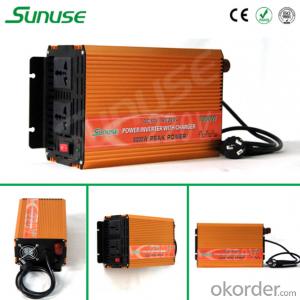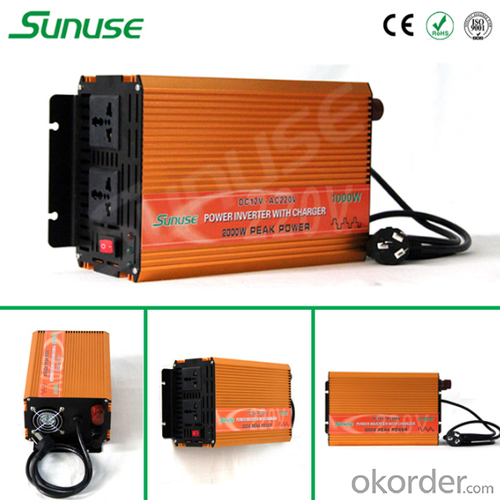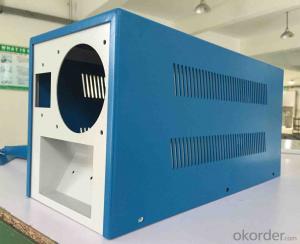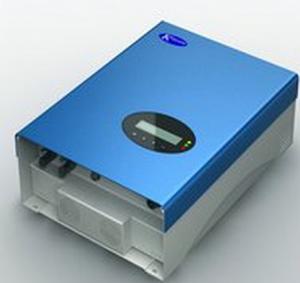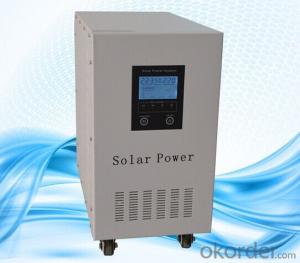Fimer Solar 1000W Home UPS Inverter 12V 220V with UPS Function
- Loading Port:
- Qingdao
- Payment Terms:
- TT or LC
- Min Order Qty:
- 50 unit
- Supply Capability:
- 30000 unit/month
OKorder Service Pledge
OKorder Financial Service
You Might Also Like
1. Structure of 1000W Home Ups Inverter, Inverter 12V 220V 1000W with Ups Function Description
A solar inverter, or PV inverter, or Solar converter, converts the variable direct current (DC) output of a photovoltaic (PV) solar panel into a utility frequency alternating current (AC) that can be fed into a commercial electrical grid or used by a local, off-grid electrical network. It is a critical BOS–component in a photovoltaic system, allowing the use of ordinary AC-powered equipment. Solar inverters have special functions adapted for use with photovoltaic arrays, including maximum power point tracking and anti-islanding protection.
2. Main Features of the 1000W Home Ups Inverter, Inverter 12V 220V 1000W with Ups Function
﹒Convert 12V/24V DC to 220V/110V AC to supply for the electronic products such as player MP3, player MP4
﹒DC 12/24V to AC 110/220V
﹒1000W home ups inverter
﹒Inverter 12v 220v 1000w with ups function
3. 1000W Home Ups Inverter, Inverter 12V 220V 1000W with Ups Function Images
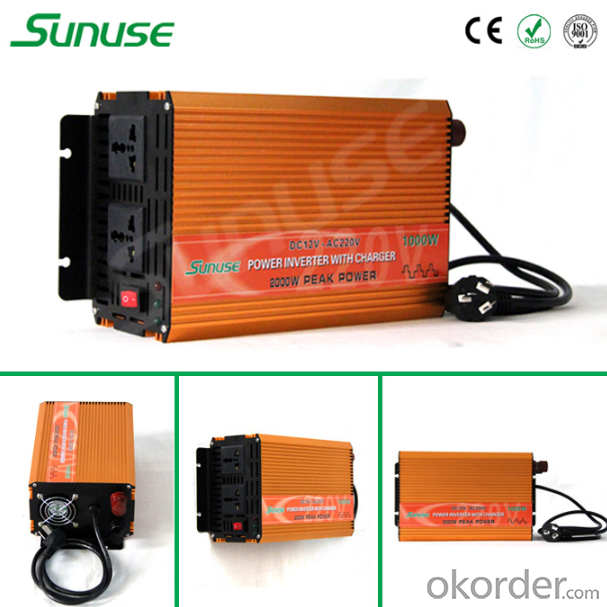
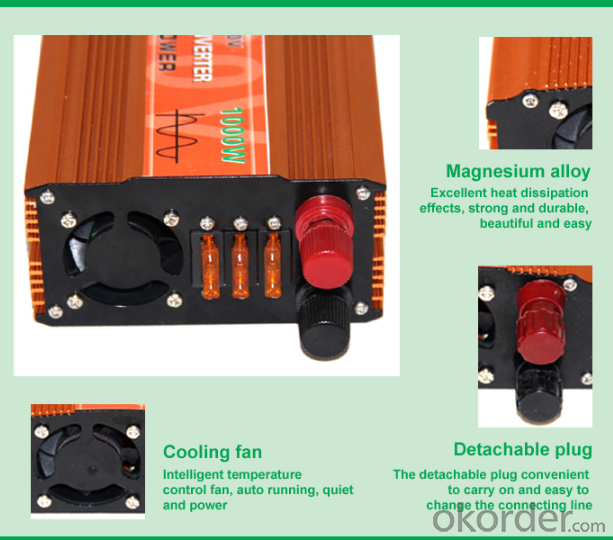
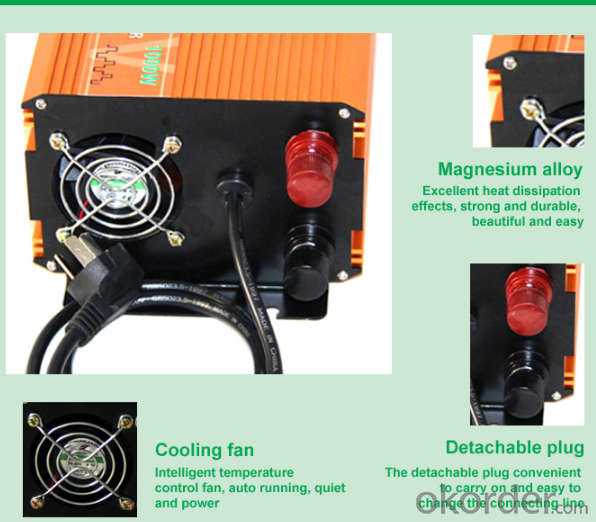
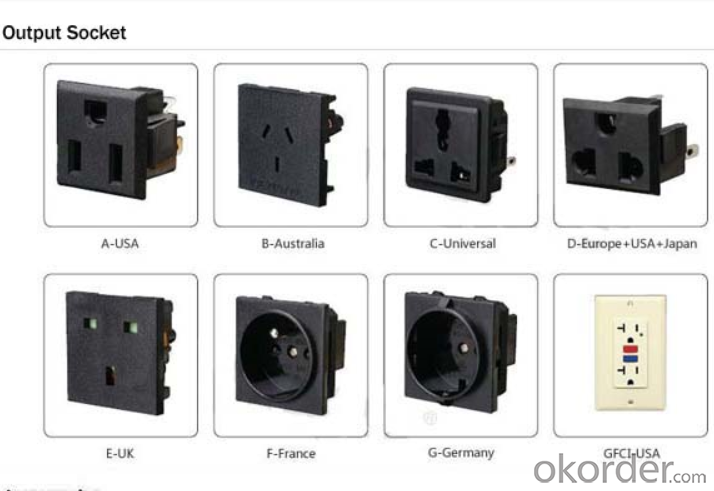
4. 1000W Home Ups Inverter, Inverter 12V 220V 1000W with Ups Function Specification
Input part | |
DC voltage: | 12V or 24V |
Voltage range: | 10-15VDC or 21-30VDC |
No load current draw: | <0.3a< span=""> |
Efficiency: | >92% |
DC connection: | Cables with clips |
Output part | |
AC voltage: | 100-120V or 220-240V |
Frequency: | 50Hz/60 Hz |
Continuous power: | 1000W |
Surge power: | 2000W |
Wave form: | modified sine wave |
AC regulation: | 3% |
Charge part | |
Charge current: | 10A |
Charge voltage: | 12V/24V |
Charge mode: | Three-gradation |
Protection part | |
Low voltage alarm: | 10DC±0.5V or 20.5DC±1V |
Low voltage shut down: | 9.5DC±0.5V or 19.5DC±1V |
Over load: | shut off output |
Over voltage shut down: | 15.5V or 30.5V |
Over thermal | shut off output automatically |
Environment part | |
Working temperature: | between -10°C and +50°C |
Working humidity: | 20% ~ 90% RH |
Storage temperature: | between -30°C and +70°C |
Package part | |
Machine size: | 235*150*100mm |
Packing size: | 355*250*163mm |
Net weight: | 2.55kg |
Gross weight: | 2.85kg |
Packing: | carton packaging |
Other part | |
Start: | soft start |
Cooling ways: | intelligent cooling fan |
5. FAQ of 1000W Home Ups Inverter, Inverter 12V 220V 1000W with Ups Function
Q1. What is the difference between inverter and solar inverter?
A1. Inverter only has AC inpput, but solar inverter both connect to AC input and solar panel, it saves more power.
Q2. What is the difference between MPPT&PWM?
A2. MPPT has higher efficiency, it can track the max power point and won't waste energy.
Q3. What is the waranty of product?
A3. 12 months.
- Q: How does a solar inverter handle anti-islanding protection?
- A solar inverter handles anti-islanding protection by constantly monitoring the grid's voltage and frequency. If a disruption or loss of grid power is detected, the inverter immediately shuts down to prevent the solar energy from being fed back into the grid and potentially causing harm to utility workers or damaging the grid infrastructure. This safety mechanism ensures that the solar system is isolated from the grid during a power outage, allowing for a safe and efficient operation.
- Q: Can a solar inverter be used with other renewable energy sources like wind or hydro power?
- Yes, a solar inverter can be used with other renewable energy sources like wind or hydro power. Inverters are designed to convert the direct current (DC) produced by renewable energy sources into alternating current (AC) that can be used to power homes and businesses. So, by connecting wind turbines or hydroelectric generators to a solar inverter, the generated DC power can be efficiently converted and integrated into the electrical grid or used for various applications.
- Q: Can a solar inverter be used in areas with high levels of electrical noise or interference?
- Yes, a solar inverter can be used in areas with high levels of electrical noise or interference. However, it is important to ensure that the solar inverter is designed and equipped to handle such conditions. Some modern solar inverters have built-in features and technologies that help mitigate electrical noise and interference. These features may include advanced filtering, shielding, and surge protection mechanisms. Additionally, proper grounding and installation practices can also help reduce the impact of electrical noise and interference on the performance of the solar inverter. It is advisable to consult with a professional or the manufacturer of the solar inverter to ensure compatibility and optimal performance in high-noise environments.
- Q: Can a solar inverter be used in systems with different module efficiencies?
- Yes, a solar inverter can be used in systems with different module efficiencies. Solar inverters are designed to convert the DC power generated by solar modules into AC power that can be used in the electrical grid or for consumption. They are generally compatible with a wide range of module efficiencies and can efficiently handle different power outputs from the solar panels. However, it is important to ensure that the inverter's power rating matches the system's total power output to ensure optimal performance and efficiency.
- Q: How does shade affect the performance of a solar inverter?
- Shade negatively impacts the performance of a solar inverter as it reduces the amount of sunlight reaching the solar panels, thereby reducing the amount of electricity generated. Inverters are designed to operate optimally under full sunlight, and when shaded, their efficiency decreases, leading to a decrease in overall energy production. Additionally, shade can cause hotspots on panels, potentially damaging the system and reducing its lifespan. To ensure maximum performance, it is important to minimize shade and ensure unobstructed sunlight for solar inverters.
- Q: What is the role of power ramp rate control in a solar inverter?
- The role of power ramp rate control in a solar inverter is to regulate the rate at which the power output of the solar system increases or decreases. This control is important to ensure the stability and reliability of the grid, as sudden changes in power generation can cause disruptions. By gradually ramping up or down the power output, the solar inverter can respond to grid conditions and prevent overloading or underutilization of the system, ultimately improving the overall performance and efficiency of the solar installation.
- Q: Can a solar inverter be used with smart home systems?
- Yes, a solar inverter can be used with smart home systems. Smart home systems are designed to integrate and control various devices and appliances, including solar inverters. By connecting the solar inverter to a smart home system, users can monitor and manage their solar energy production, track energy consumption, and optimize energy usage for maximum efficiency. This integration allows for greater control and automation of the solar power system within the smart home ecosystem.
- Q: How is a solar inverter different from a regular inverter?
- A solar inverter is specifically designed to convert the DC (direct current) electricity generated by solar panels into AC (alternating current) electricity that can be used to power household appliances and be fed back into the grid. On the other hand, a regular inverter is generally used to convert DC power from batteries or other sources into AC power. Therefore, the main difference lies in their purpose and the source of the DC electricity they handle.
- Q: How does a solar inverter monitor and optimize energy production?
- A solar inverter monitors and optimizes energy production by converting the direct current (DC) generated by solar panels into alternating current (AC) that can be used to power electrical devices. It constantly monitors the voltage and current of the solar panels to ensure optimal performance and adjusts the conversion process accordingly. Additionally, advanced solar inverters often incorporate maximum power point tracking (MPPT) technology, which enables them to track the maximum power output of the solar panels and adjust their operating parameters accordingly, maximizing energy production. This monitoring and optimization process helps to ensure efficient and effective utilization of solar energy.
- Q: Can a solar inverter be used for both residential and commercial applications?
- Yes, a solar inverter can be used for both residential and commercial applications. Solar inverters are designed to convert the direct current (DC) electricity generated by solar panels into alternating current (AC) electricity, which is suitable for use in homes and businesses. They are versatile and can be scaled up or down depending on the size of the solar power system, making them suitable for both residential and commercial installations.
Send your message to us
Fimer Solar 1000W Home UPS Inverter 12V 220V with UPS Function
- Loading Port:
- Qingdao
- Payment Terms:
- TT or LC
- Min Order Qty:
- 50 unit
- Supply Capability:
- 30000 unit/month
OKorder Service Pledge
OKorder Financial Service
Similar products
Hot products
Hot Searches
Related keywords
